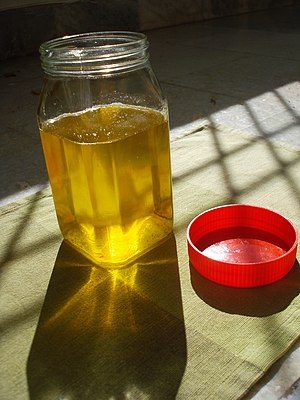ギー
Ghee/ja
 | |||||||||||||||||||
| Nutritional value per 100 g (3.5 oz) | |||||||||||||||||||
|---|---|---|---|---|---|---|---|---|---|---|---|---|---|---|---|---|---|---|---|
| Energy | 3,660 kJ (870 kcal) | ||||||||||||||||||
0 g | |||||||||||||||||||
99.5 g | |||||||||||||||||||
| Saturated | 61.9 g | ||||||||||||||||||
| Monounsaturated | 28.7 g | ||||||||||||||||||
| Polyunsaturated | 3.69 g | ||||||||||||||||||
0.3 g | |||||||||||||||||||
| |||||||||||||||||||
| Other constituents | Quantity | ||||||||||||||||||
| Water | 0.24 g | ||||||||||||||||||
| Cholesterol | 256 mg | ||||||||||||||||||
| †Percentages estimated using US recommendations for adults, except for potassium, which is estimated based on expert recommendation from the National Academies. | |||||||||||||||||||
ギーとは、インド亜大陸を発祥とする澄ましバターの一種である。料理、伝統医学、そしてヒンドゥー教の宗教儀式に広く用いられている。
概要
ギーはたいてい、バターを煮詰めることで作られる。このバターはクリームを攪拌して得られたものであり、表面に浮上した不純物をすくい取った後、澄んだ液状の脂肪を注ぎ出して残し、底に沈殿した固形分は廃棄する。風味付けのためにスパイスを加えることもある。ギーの舌触り、色、そして味は、バターの質、製造過程で用いられる乳、そして煮沸時間に左右される。
語源
ギーという言葉は、ヒンディー語の「घी」(ghī)に由来し、これはサンスクリット語の「Sanskrit: घृत」(ghṛta-、sa)「澄ましバター」から来ており、その語源は「振りかける」を意味するサンスクリット語のघृ(ghṛ-)である。これは古代ギリシャ語のχριστός(khristós、「擦られた、油を塗られた」の意)と同族語であり、そこから英語のキリストという言葉が派生したのである。
ヒンドゥー教において
伝統的に、ギーは牛または水牛の乳から作られ、ヴェーダ時代以来、儀式に用いられてきた。これはヴェーダの「ヤジュニャ」および「ホーマ」(火の儀式)において神聖な必須品であり、アグニ(火)を介して様々な神々に供物を捧げるために用いられる(参照:ヤジュールヴェーダ)。
結婚式や葬儀といった儀式には火の儀式が用いられる。ギーはムールティ(神聖な神々)のヴェーダ礼拝において不可欠であり、「アーラティ」(ギーランプの奉納)は「ディヤー」または「ディーパ」と呼ばれ、また「パンチャームルタ」においても必要とされる。パンチャームルタにおいては、ミシュリ、蜂蜜、牛乳、そしてダーヒ(凝乳)と共にギーが用いられ、クリシュナの降誕日であるジャンマシュタミーや、シヴァの「マハーシヴァラートリー」(マハー・シヴァラートリー)に神像を沐浴させる際に使用される。ギーに対する賛歌も存在する。「マハーバーラタ」においては、「カウラヴァ」がギーの壺から生まれたとされる。
ギーはまた、「バング」においても用いられ、大麻を加熱して脱炭酸を促し、その飲み物を精神活性させるのである。
仏教経典においては、乳製品の生産段階が悟りの段階の比喩として用いられる。最も高次の段階の生成物である「サルピル・マンダ」は、ギーまたは澄ましバターであると理論づけられている。
料理における用途
ギーはインド亜大陸の料理、伝統的な米料理(ビリヤニなど)で一般的である。マハーラーシュトラ州では、ポリやインドのフラットブレッドにギーが添えられる。例えば、典型的なマハーラーシュトラ料理である「プラナポリ」は、大量のギーと共に食される。ラージャスターン州では、ギーはしばしば「バーティ」に添えられる。北インド全域では、「ロティ」がギーと共に供される。カルナータカ州およびタミル・ナードゥ州では、ギーはドーサやケサリ・バートと共に提供される。ベンガル(西ベンガルとバングラデシュの両方)とグジャラート州では、「キチュリ」が米とレンズ豆を用いた伝統的な夕食であり、ダーヒ(凝乳)、クミンシード、カレーリーフ、コーンフラワー、ターメリック、ニンニク、塩、そしてギーで作られたカレーで調理される。また、「カディ」や、インドの菓子、例えば「マイソール・パーク」や様々な種類の「ハルヴァ」および「ラッドゥ」の材料でもある。インド料理店では通常、大量のギーを取り入れ、時には調理中または提供直前に「ナーン」や「ロティ」に塗る。オリッサ州では、ギーは「ケチェディ」や「ダルマ」などのオリッサ料理で広く用いられる。特に、オリッサのほとんどの寺院で用意されるサットヴァ食は、その料理の伝統においてギーを主要な材料としている。ギーは南インド料理において、カレーの風味付けや米料理、菓子の調理に用いられる。北インドの人々もまた、ピクルス、ダル、カレーと共に米を食べる前にギーを加える。北インド人はギーの最大の消費者の一つである。アーンドラ・プラデーシュ州のベジタリアン料理では特に、ギーを鹹味料理と甘味料理の両方の調理に用いる。ギーは伝統的な北インド料理にとって重要であり、「パラタ」、「ダール」、カレーでは、より豊かな風味のために油の代わりにギーが頻繁に使用される。動物の供給源という点でギーの種類は料理によって異なり、例えば、牛乳から作られたギー(Bengali: গাওয়া ঘী, gaoa ghi)は米や「ロティ」と共にするか、カレーやダル(レンズ豆)の仕上げに少量かけるのが伝統的であるのに対し、水牛乳のギーは一般的な調理目的により典型的である。
ギーは揚げ物用の脂肪として有用である。なぜなら、その発煙点(分子が分解し始める温度)は250 °C (482 °F)であり、これは一般的な調理温度である約200 °C (392 °F)を大きく上回り、ほとんどの植物油の発煙点よりも高いのである。
Flavour
The main flavour components of ghee are carbonyls, free fatty acids, lactones, and alcohols. Along with the flavour of milk fat, the ripening of the butter and the temperature at which it is clarified also affect the flavour. For example, ghee produced at 100 °C (212 °F) or lower has a milder flavour, whereas 120 °C (248 °F) results in a strong flavour.
Differences from clarified butter
The production of ghee differs slightly from that of clarified butter. The process of creating clarified butter is complete once the water is evaporated and the fat (clarified butter) is separated from the milk solids. However, the production of ghee includes simmering the butter, which makes it nutty-tasting and aromatic.
A traditional Ayurvedic recipe for ghee is to boil raw milk and let it cool to 43 °C (109 °F). After leaving it covered at room temperature for around 12 hours, add a bit of dahi (yogurt) to it and leave it overnight. This makes more yogurt. This is churned with water, to obtain cultured butter, which is used to simmer into ghee.
Nutrition and health
Like any clarified butter, ghee is composed almost entirely of fat, 62% of which consists of saturated fats. Most commercial preparations in India were also found to contain significant amounts of trans fats. It has negligible amounts of lactose and casein and is, therefore, acceptable to most people who have a lactose intolerance or milk allergy.
Ghee consumption has been associated with an increased risk of cardiovascular disease. The British Dietetic Association, British Nutrition Foundation, National Health Service, Heart and Stroke Foundation of Canada and World Health Organization advise people to limit ghee consumption due to its high saturated fat content.
Preparation methods
There are five common methods through which ghee is prepared. Industrial preparation on the other hand is done by using "white butter", usually sourced from other dairies and contractors.

Milk butter
Sour raw milk is churned into butter. The butter is boiled in an open pan to allow the water to evaporate. The hot ghee is transferred and stored.
Direct cream
Fresh cream, cultured or washed cream is directly converted to ghee. This method requires a long heating time and produces a caramelized flavor.
Cream butter
Milk is separated into cream which is then churned into butter. The butter undergoes heat clarification to produce ghee.
Pre-stratification
This method is suitable for large quantities of butter. Butter is melted at 80–85 °C (176–185 °F) for 30 minutes. Layers of protein particles, fat and buttermilk are induced. The buttermilk is drained out. The remaining layers of fat are heated to a temperature of 110 °C (230 °F) to remove moisture and develop flavor.
Packaging

Ghee is generally found to be packaged in airtight glass jars. They should be kept away from direct sunlight as sunlight can cause moisture to build inside the jar. Moisture can cause deterioration to the ghee's quality as well as reduce its shelf life. To prevent the acceleration of the oxidation process, they should be protected from anything that causes it, such as UV rays from sunlight and fluorescent lights. If the jar is unopened, it does not need to be refrigerated as long as the previously mentioned conditions are met. Once opened, they can be stored in a kitchen cabinet for up to three months. Afterwards, it may be left in the refrigerator for up to a year. The refrigerator causes ghee to harden but if it is left at room temperature for a while, it will soften up again.
Composition
Ghee may be made of milk from various domesticated ungulates, such as cows, buffaloes and sheep. The composition of ghee varies depending on the animal whose milk has been used. The vitamin A content ranged from 315 to 375 μg per 100 grams. Palmitic acid and oleic acid were two of the main fatty acids found in both cow and sheep ghee. The saturated fatty acid profile was 53.9 to 66.8%, the unsaturated fatty acid profile was 22.8 to 38.0% and the other fatty acids was 3.5 to 10.4%. Cholesterol amounts ranged from 252 to 284 mg/100 grams.
Market
The market size of ghee in India is 10,000 crore rupees or US$1.5 billion as of 2016. India is the world's largest producer of buffalo and cow milk and consequently also the largest producer and consumer of ghee.
関連項目
| この記事は、クリエイティブ・コモンズ・表示・継承ライセンス3.0のもとで公表されたウィキペディアの項目Ghee(25 April 2025, at 02:20編集記事参照)を翻訳して二次利用しています。 |
